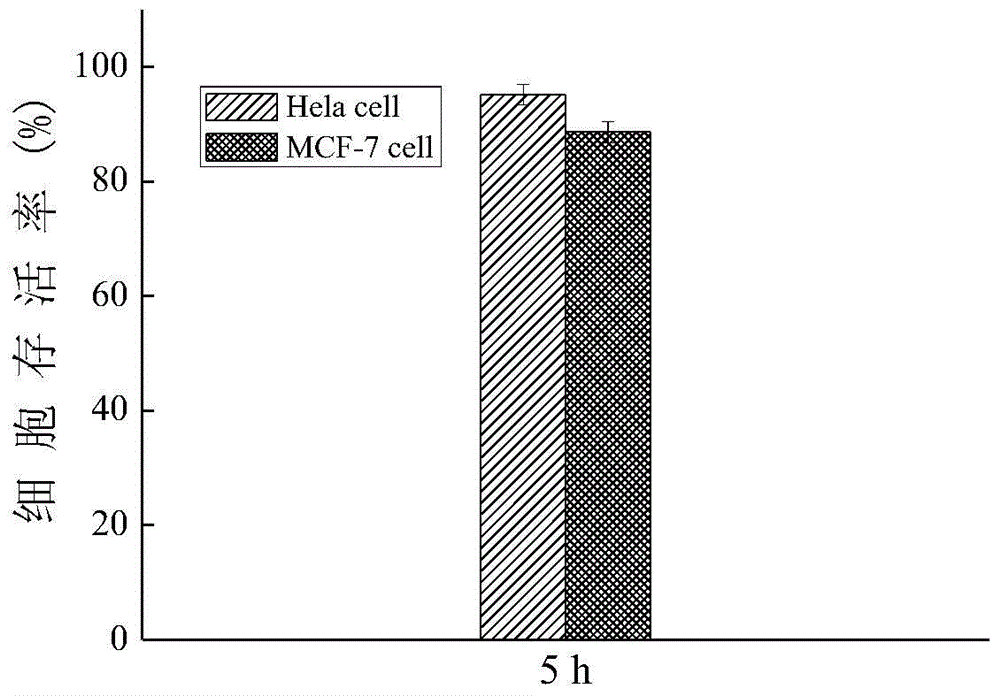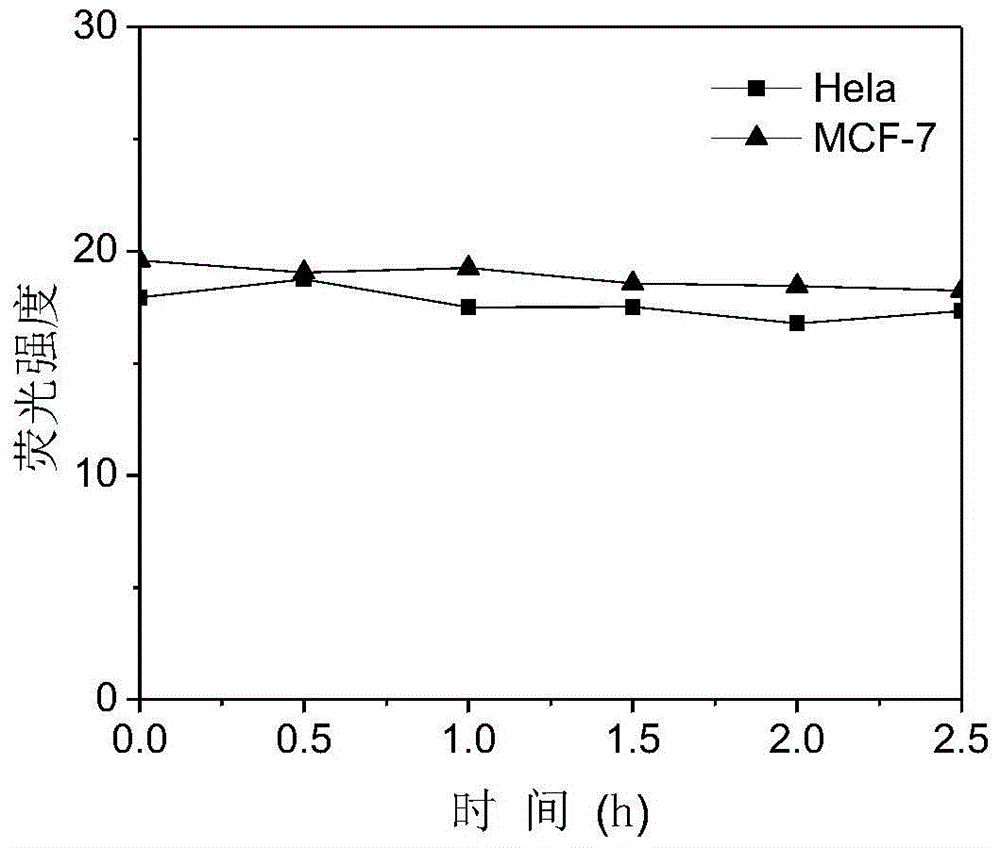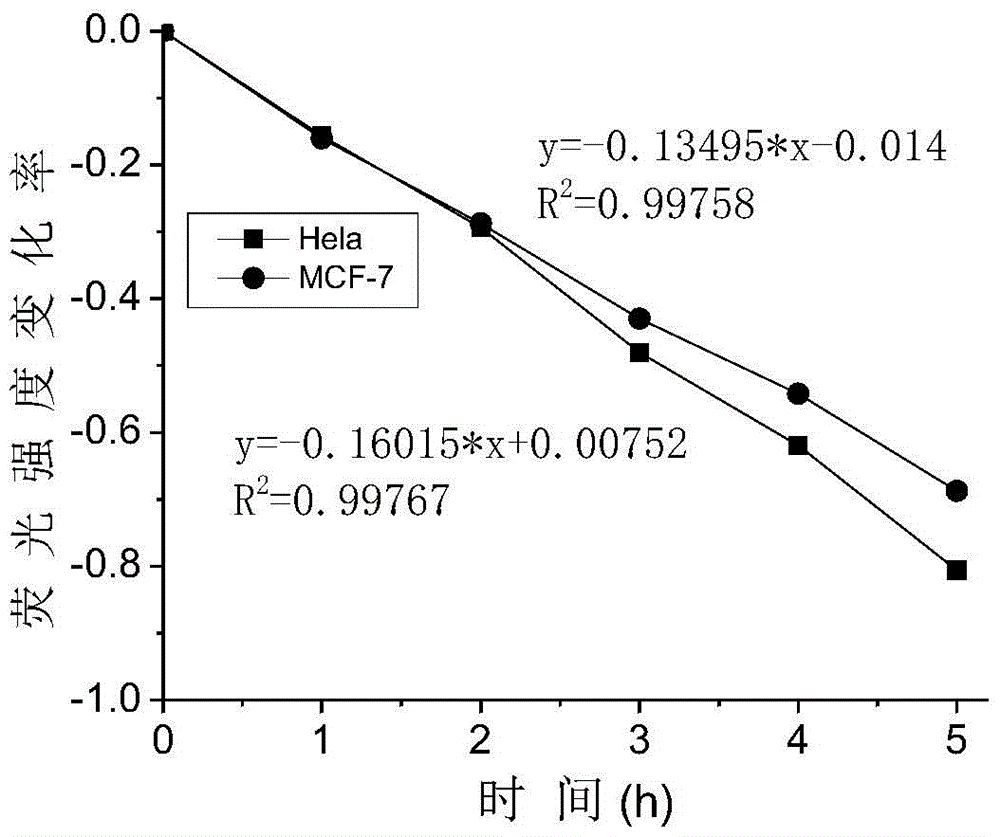A method for quantitatively detecting the amount of carbon dioxide exhaled by cancer cells
A technology for quantitative detection of carbon dioxide, applied in the field of fluorescent biosensors, can solve the problems of not being able to monitor the metabolic process of cancer cells and not having the ability to quantitatively detect carbon dioxide in cells
- Summary
- Abstract
- Description
- Claims
- Application Information
AI Technical Summary
Problems solved by technology
Method used
Image
Examples
Embodiment 1
[0043] (1) Dissolve 0.64mg TPP-DMAE in 0.01mL dimethyl sulfoxide (DMSO) to obtain a concentration of 1×10 -2 mol / L solution a; add 10mL high-sugar DMEM medium to solution a to obtain a concentration of 1×10 -5 mol / L solution b.
[0044] (2) ① In order to detect whether TPP-DMAE can cause the inactivation of Hela cell and MCF-7cell within the test time range, the following toxicity test experiments were done:
[0045] Cervical cancer cells (Hela cells) and breast cancer cells (MCF-7 cells) were respectively passaged into two culture dishes dedicated to confocal laser microscopy (confocal); the Hela cells, MCF-7cell was digested with 0.05% trypsin until 50-60% of the cells were detached from the bottom of the culture dish, and 3 mL of high-sugar DMEM medium was added to the culture dish of Hela cell and MCF-7 cell to stop the digestion, and then Hela cell Cell and MCF-7cell suspensions were transferred from the petri dish to two 15mL centrifuge tubes, each supplemented with 7m...
Embodiment 2
[0055] (1) Dissolve 0.64mgTPP-DMAE in 0.01mL dimethyl sulfoxide (DMSO) to obtain a concentration of 1×10 -2 mol / L solution a; add 10mL high-sugar DMEM medium to solution a to obtain a concentration of 1×10 -5 mol / L solution b.
[0056] (2) ① In order to detect whether TPP-DMAE can cause the inactivation of Hela cell and MCF-7cell within the test time range, the following toxicity test experiments were done:
[0057] Cervical cancer cells (Hela cells) and breast cancer cells (MCF-7 cells) were respectively passaged into two culture dishes dedicated to confocal laser microscopy (confocal); the Hela cells, MCF-7cell was digested with 0.05% trypsin until 50-60% of the cells were detached from the bottom of the culture dish, and 3 mL of high-sugar DMEM medium was added to the culture dish of Hela cell and MCF-7 cell to stop the digestion, and then Hela cell Cell and MCF-7cell suspensions were transferred from the petri dish to two 15mL centrifuge tubes, each supplemented with 7mL...
Embodiment 3
[0067] (1) Dissolve 0.64mg TPP-DMAE in 0.01mL dimethyl sulfoxide (DMSO) to obtain a concentration of 1×10 -2 mol / L solution a; add 10mL high-sugar DMEM medium to solution a to obtain a concentration of 1×10 -5 mol / L solution b.
[0068] (2) ① In order to detect whether TPP-DMAE can cause the inactivation of Hela cell and MCF-7cell within the test time range, the following toxicity test experiments were done:
[0069] Cervical cancer cells (Hela cells) and breast cancer cells (MCF-7 cells) were respectively passaged into two culture dishes dedicated to confocal laser microscopy (confocal); the Hela cells, MCF-7cell was digested with 0.05% trypsin until 50-60% of the cells were detached from the bottom of the culture dish, and 3 mL of high-sugar DMEM medium was added to the culture dish of Hela cell and MCF-7 cell to stop the digestion, and then Hela cell Cell and MCF-7cell suspensions were transferred from the petri dish to two 15mL centrifuge tubes, each supplemented with 7m...
PUM
 Login to View More
Login to View More Abstract
Description
Claims
Application Information
 Login to View More
Login to View More - R&D Engineer
- R&D Manager
- IP Professional
- Industry Leading Data Capabilities
- Powerful AI technology
- Patent DNA Extraction
Browse by: Latest US Patents, China's latest patents, Technical Efficacy Thesaurus, Application Domain, Technology Topic, Popular Technical Reports.
© 2024 PatSnap. All rights reserved.Legal|Privacy policy|Modern Slavery Act Transparency Statement|Sitemap|About US| Contact US: help@patsnap.com










